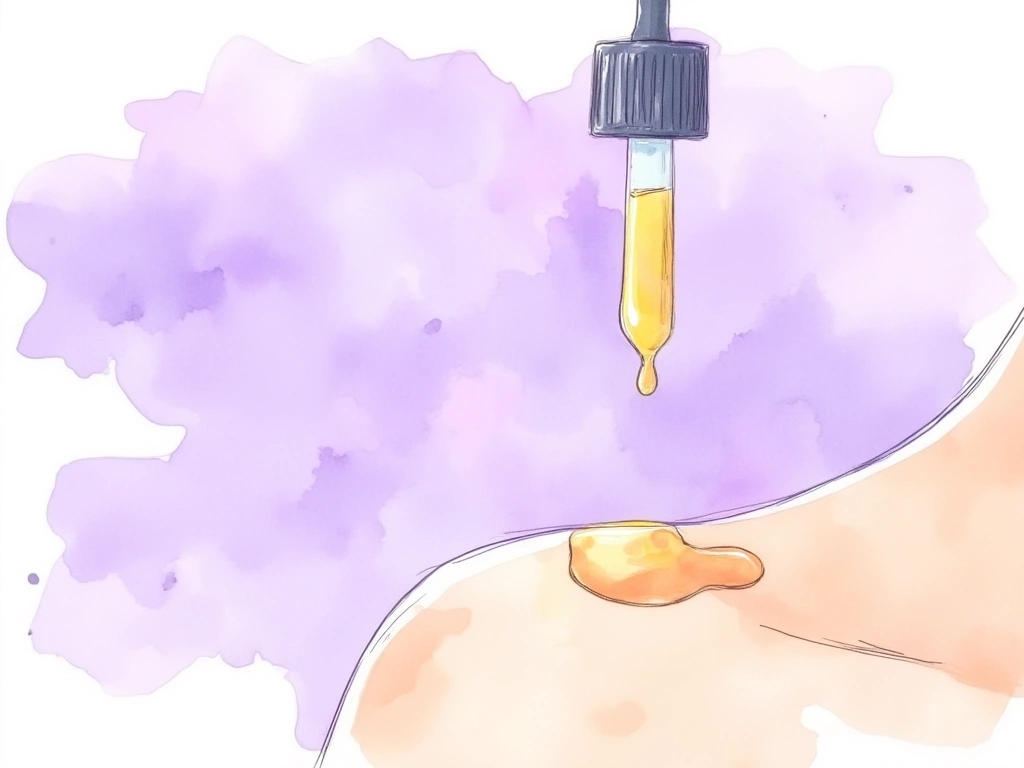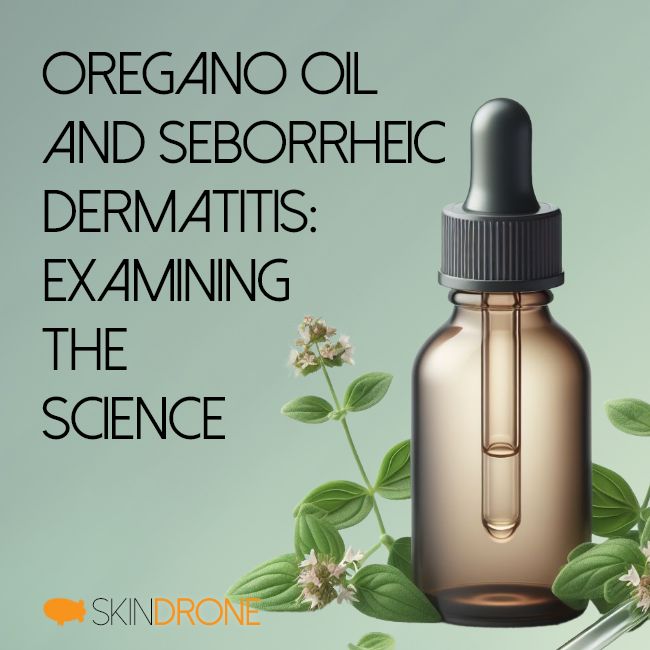- Seborrheic dermatitis is a common skin condition with red, flaky patches.
- Oregano oil shows promise due to its antifungal and anti-inflammatory properties.
- Early research and user experiences suggest potential benefits, but more studies are needed.
- Dilution and caution are essential when using oregano oil topically.
- Consult a dermatologist before trying oregano oil for seborrheic dermatitis.
Seborrheic dermatitis, a widespread skin issue, manifests as red, flaky, and greasy patches predominantly on the scalp, face, chest, and back [1]. While the precise cause remains elusive, a combination of factors, including fungal involvement, yeast overgrowth, excessive oil production, and immune system irregularities, are believed to contribute [2].
Although there’s no known cure for seborrheic dermatitis, various treatments can effectively manage its symptoms. These range from medicated shampoos and creams to alternative and natural remedies. Among these, oregano oil is gaining traction as a potential option.
Derived from the oregano plant, a member of the mint family, oregano oil is rich in compounds like carvacrol and thymol. These components are known for their antibacterial, antifungal, and anti-inflammatory properties [3].
While anecdotal accounts suggest that some individuals with seborrheic dermatitis have found relief using oregano oil, it’s crucial to examine the scientific evidence. Let’s delve into the potential of this natural oil and what research reveals.
Quick Summary: Oregano oil presents an interesting natural option for seborrheic dermatitis, supported by initial studies. However, it’s important to be cautious due to limited clinical trials. It may serve as a complementary treatment, but always prioritize patch testing and professional dermatological advice for managing this ongoing skin condition.

Understanding How Oregano Oil May Target Seborrheic Dermatitis
Oregano oil’s potential to alleviate seborrheic dermatitis symptoms is linked to several key properties:
1. Combating Fungal Overgrowth
An overabundance of fungi, particularly Malassezia yeasts, is implicated in both dandruff and seborrheic dermatitis [4]. Oregano oil has demonstrated significant antifungal activity in laboratory settings, suggesting it may help control these fungi on the skin [5] [6].
2. Reducing Inflammation
Inflammation is a primary driver of the redness, flakiness, and itchiness associated with seborrheic dermatitis. Research indicates that oregano oil possesses anti-inflammatory properties [7], which could help soothe irritated skin and reduce visible symptoms.
3. Balancing Skin Microbiota
An imbalance in the skin’s natural microbial community is observed in individuals with seborrheic dermatitis [8]. Oregano oil’s broad antimicrobial effects may contribute to restoring a healthier balance of skin microbes [9].

Exploring the Science: Oregano Oil and Skin Health
While direct studies on humans with seborrheic dermatitis are still needed, preliminary laboratory research provides insights into oregano oil’s potential benefits for skin and inflammation:
- Accelerated Skin Healing: Oregano oil promoted faster migration and healing of human skin cells, crucial for skin repair [10].
- Inflammation Reduction: It reduced the release of inflammatory compounds from immune cells, suggesting an anti-inflammatory action [11].
- Improved Colon Inflammation: In a mouse model of colitis, oregano oil improved colon inflammation, indicating systemic anti-inflammatory potential [12].
- Reduced Allergic Skin Reactions: Animal models of skin allergy showed reduced skin reactions with oregano oil, further supporting its anti-inflammatory effects [13].
Furthermore, oregano oil is a source of antioxidants, which can protect the skin from damage [7]. Overall, early research suggests oregano oil may aid in skin healing, soothing, and protection.

Real-World Experiences: Oregano Oil for Seborrheic Dermatitis
Despite the lack of extensive clinical trials, some individuals with seborrheic dermatitis have turned to oregano oil to manage their symptoms.
Analyzing discussions from Reddit threads focused on skin issues reveals a range of experiences with topical and oral oregano oil use:
- Topical Application: Some users reported positive outcomes from applying undiluted oregano oil directly to affected areas, particularly on the scalp and skin Source. However, they emphasized the potential for pain and irritation if not properly diluted. Carrier oils like jojoba oil were recommended for dilution Source.
- Oral Consumption: Others reported improvements in seborrheic dermatitis symptoms after taking oregano oil capsules, though specific dosages were not consistently mentioned SourceSource.
- Antifungal Mechanism: The perceived antifungal properties of oregano oil are frequently cited as the reason for its potential effectiveness in controlling dandruff, redness, and inflammation associated with seborrheic dermatitis SourceSource.
- Consistency and Long-Term Use: Anecdotal evidence suggests that consistent, long-term application might be necessary to maintain improvements. The time frame for noticing benefits varied significantly among users SourceSource.
These personal accounts offer preliminary support for oregano oil as a potential symptomatic relief option for some individuals with seborrheic dermatitis. However, it’s important to remember that these are not controlled studies, and formal clinical trials are needed to confirm efficacy and establish safe usage guidelines.

Forms of Oregano Oil: Essential Oils, Creams, and Capsules
Oregano oil is available in several forms, each with different applications:
- Oregano Essential Oil: This is a highly concentrated liquid extracted from oregano leaves. Crucially, it must always be diluted before topical application to avoid skin irritation or burns.
- Oregano Oil Creams and Ointments: These products typically contain diluted essential oil (usually 0.6-1%) formulated for direct skin application.
- Oregano Oil Capsules: These capsules contain essential oil for oral consumption and should be food or medical grade.
For topical use, diluted creams or ointments may be safer and less irritating than undiluted essential oils. It’s also important to note that product quality can vary significantly across brands.

Safety Considerations: Is Oregano Oil Right for You?
Despite promising research, oregano oil use is not without potential risks:
- Skin Irritation: It can cause irritation or burning, especially on sensitive areas like the face.
- Allergic Reactions: Allergic reactions are possible in susceptible individuals.
- Limited Long-Term Data: Safety data on long-term use is limited.
- Quality Concerns: Product purity and quality can vary.
- Limited Human Studies: Human research, particularly for seborrheic dermatitis, is still in early stages.
To minimize risks with topical applications, proper dilution, patch testing, and choosing reputable brands are essential. For oral forms, starting with a low dose and monitoring for reactions is advisable.
Always consult with a dermatologist before using oregano oil for seborrheic dermatitis.

Practical Tips for Using Oregano Oil
If you and your doctor decide to try oregano oil for seborrheic dermatitis, keep these guidelines in mind:
For Essential Oils:
- Always Dilute: Mix with a carrier oil (like jojoba or coconut oil) before applying to the skin.
- Start with Low Dilution: Begin with a 3-5% dilution.
- Patch Test: Apply to a small area (like your arm) and wait 24-48 hours to check for reactions before applying more broadly.
- Avoid Sensitive Areas: Keep away from eyes and mucous membranes.
For Creams and Ointments:
- Check Ingredients: Review the ingredient list carefully before purchase.
- Patch Test: Test on a small area for 1-2 days before wider application.
- Start Gradually: Apply to less sensitive areas first, before the face or scalp.
- Discontinue if Irritation Occurs: Reduce use or stop altogether if burning or stinging develops.
For Oral Capsules:
- Choose Quality Brands: Opt for high-quality, food/medical grade brands.
- Follow Dosage: Adhere to package dosing instructions carefully.
- Take with Food: Consume with food to minimize potential stomach upset.
- Reduce Dose if Reactions Occur: Lower the dosage if you notice any adverse reactions.
Using lower concentrations and careful monitoring are prudent practices for any form of oregano oil. Combining it with other anti-dandruff strategies may also improve effectiveness and tolerability.

Exploring Alternative Natural Treatments
While oregano oil shows promise, several other natural and alternative therapies have more established evidence for managing seborrheic dermatitis:
- Tea Tree Oil: Its anti-inflammatory, antibacterial, and antifungal properties make diluted tea tree oil a helpful topical treatment and shampoo ingredient.
- Aloe Vera: The gel from the aloe vera plant soothes and reduces redness and irritation when applied to the skin.
- Honey: Raw honey’s antimicrobial and moisturizing qualities can help alleviate scaling and inflammation when used topically.
- Probiotics: Certain probiotic strains may positively influence gut health and immune pathways relevant to seborrheic dermatitis.
- Stress Management: Stress can worsen seborrheic dermatitis; relaxation techniques like meditation can be beneficial adjuncts to treatment.
- Diet Modification: Dietary adjustments, such as reducing oils, dairy, and sugars and increasing anti-inflammatory foods, may offer additional relief for some individuals.
Combining oregano oil with these other natural approaches could be a comprehensive strategy. While more research is always beneficial, existing evidence already supports the potential of several alternative therapies.

Key Takeaway: Oregano Oil as a Potential Complementary Approach
Early scientific findings and personal experiences suggest that oregano oil could be a supplementary option for managing seborrheic dermatitis symptoms. When used cautiously and correctly, it appears to be reasonably safe for many individuals.
However, it’s crucial to emphasize that rigorous clinical trials in human patients are still necessary to definitively prove its effectiveness and establish clear usage guidelines. Always consult your dermatologist before trying oregano oil or any new treatment for seborrheic dermatitis.
While not yet a proven treatment, oregano oil may offer an additional avenue for relief alongside conventional medicated treatments.

No Comments
Be the first to start a conversation